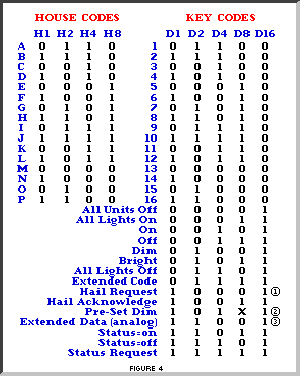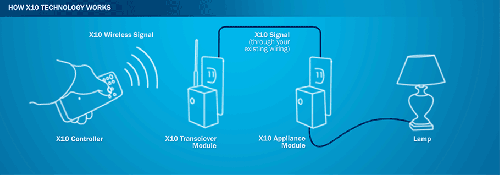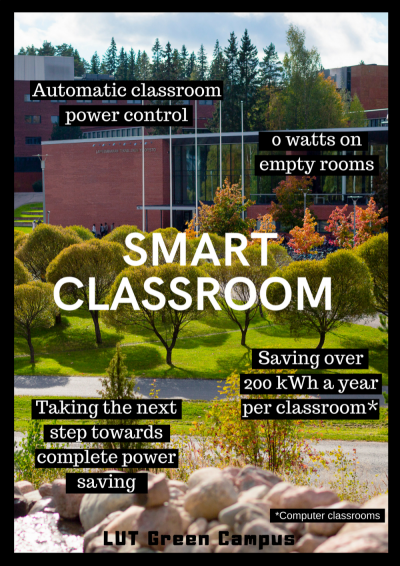meta data for this page
Smart classroom
Group Name: Skynet
Group Members:
| Name | Student number |
|---|---|
| Hannes Hietanen | 0403053 |
| Severi Ahopelto | 0454293 |
| Md Anisul Islam | 0528721 |
Idea and motivation
Modern classrooms use many kinds of technology and equipment: computers, monitors, TVs, projectors, printers, etc. These devices consume some power when plugged into an outlet even when they are turned off. The consumption of an individual device is very low, but when you consider that LUT, and schools in general, have hundreds of computers and other devices which are not in use most of the time, for example at night or on holidays, it adds up to significant amounts. Eliminating this unnecessary consumption could save a lot of money.
We will try to solve this problem with our automated system which completely shuts down the power in a classroom when it is not in use. We implemented a much simpler version of this system, by using basic home automation power meters and switches to control the power for a single computer and a light bulb.
The main motivations for this project are the energy savings, but the increased comfort from the automation of some things, such as lighting or heating, is a good benefit as well.
Vision
Our vision is a classroom with no power usage when it is not in use. In addition to the implemented features, we also thought about how this system could be improved in the future. We focused on the possibilities in 5-10 years, although some these things might be partly possible to implement even today or in the near future.
Smart windows
Automatic dimming of windows could be useful to control the amount of sunlight in the classroom. This could work together with the lighting, since the brightness of the lights can be lowered when there is a lot of natural light available from outside. The windows can be dimmed completely in situations where the classroom needs to be very dark or direct sunlight is distracting. Smart windows could also generate some power from the sunlight.
Smart walls
Smart walls can detect people inside the room more accurately than simple motion sensors. The walls could also be used as an interactive surface when necessary. The interactions could possibly be based on either touch or gestures. There would also be no need wall switches since the interactions could be done on the interactive wall.
Smart heating
Heating could be automated based on the classroom schedule. This way the classroom could be already automatically heated in the morning when the first lecture starts and the heating can be turned down or off to save energy after the last lecture in the evening.
Implemented scenario
- Calculating power consumed by all idle electronic devices and Recognizing the motion → Turning ON/OFF power supply
- Situational lighting based on Power consumption
Benefits and savings
Most people don’t think about turning school computers off and nobody unplugs their classroom electronics after leaving. Our solution provides convenience and ease of mind since those who do use school electronics responsibly won’t need to worry about shutting down devices either. Everything happens unnoticed automatically. That small convenience is the social sustainability our concept brings. Most of our projects sustainability is on environmental side. The whole idea of this concept is to save the last bit of completely wasteful power usage in classrooms. Although the impact of one room is small the combined impact of hundreds of classrooms saves a lot of energy thus reducing the emissions caused by electricity usage.
We can see from the calculations that the amount of money saved is quite small in the scale of a university but when we include all the classrooms into consideration the energy savings and cost benefits can become significant. The real issue is the cost of implementation which in our example using switches would require multiple switches in each classroom and wouldn’t be worth the investment. Our solution could be developed further and if we could manage a complete classroom with one switch the investment could be worth it. It is of course also a way of branding and enhancing the university’s image. Green campus image sells, and this solution would bring another dimension to that.
Energy savings calculations
- A simple calculation example would be to estimate energy saving in one computer classroom since they have the most electronic devices in classrooms.
- We’ll be using an LUT computer classroom in this example. In an LUT computer classroom there are around 15 computers and monitors.
- We can take standby power calculations researched by Lawrence Berkeley National Laboratory and use them in our calculations. According to their research, an LCD display consumes 1.38W of power in sleep mode and a desktop computer consumes 21.13W on average in sleep mode.
- In these estimations the hardest part is estimating what portion of the year are the computer classes not in use. We can roughly say it is at least half of the day since the rooms are not used at most nights and daytime use is small on holidays and summer.
- We can also calculate cost savings estimates using electricity prices in Finland.
- With these numbers we can calculate some estimates.
Home Automation Protocol - X10
- X10 was developed in 1975 in Scotland
- Uses power lines to transmit data
- Has been an international standard for home automation for a long time
- Communicates between transmitters and receivers
- RF bursts over power line
- A 1ms burst of 120 kHz is Binary 1 and absence of 120 kHz is Binary 0
- Complete code transmission is 11 cycles
- Bits are sent in half cycles of the power line (1ms signal on one half cycle)
- First 2 cycles are a default Start code 1110, which is always the same
- Next 4 cycles indicate the house code
- Last 5 cycles represent a Number Code or a Function Code
Image link: https://www.x10.com/media/x10/howx10works910.gif
For a more detailed explanation and more figures check the final report!
Benefits
- Uses existing wiring (no need for ethernet or wireless networks)
- Simple to use
- Been around for a long time so there are many compatible devices
- Cheaper than most alternatives
Drawbacks
- Noticeable delay
- Possible interference (data byte gaps etc.)
- Provides less functionality than alternatives
- 16 home addresses and 16 unit codes per address so only 256 different addresses
FHEM
- Open source Perl server for home automation
- Common tasks include switching devices and logging events
- Supports many protocols and devices
Our impressions
- Can be controlled with many devices, such as smartphones
- Lack of documentation
- Mess in a crowded network
- Perl Scripts and Error Logs :)
Poster
Documents
- Presentation:smart_classroom_final.pptx
- Final report: final_report.pdf
- Code: code.zip
- Poster: automation_poster_small.png
References
Lawrence Berkeley National Laboratory (2018). Standby power summary table. Available: http://standby.lbl.gov/summary-table.html
Smarthomeusa.com (2018). How X10 works. Available: https://www.smarthomeusa.com/how-x10-works/#theory





